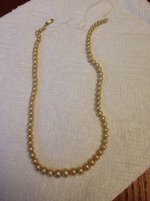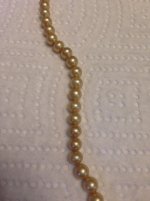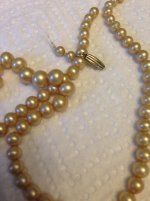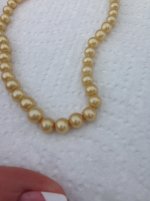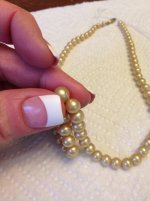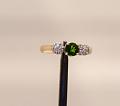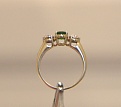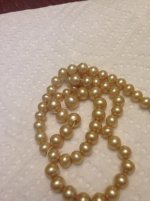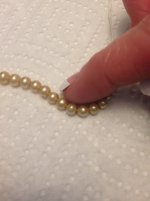Hi and welcome to Pearl-Guide. Sorry for delay, I didn't see your post until now.
Your pearls have an interesting mix of qualities. At this point I'm leaning toward imitation but there are some tests you can do.
1. Wipe the pearls clean with a damp soft cloth, then gently rub 2 of them together. Genuine pearl nacre tends to have a resistant, very slightly gritty feel. Imitation pearls generally slide easily. This is also called the tooth test when one rubs the pearl against the edge of one's front tooth.
2. If you have a 10x loupe (or visit a local jeweler and ask to use theirs), you can look at the surface of the pearls. Genuine nacre looks very smooth at that magnification, while imitations look more coarse. It helps to compare what you see against a known-fake pearl you may have, or a known-real pearl (which the jeweler may be selling.)
The pearls seem to be graduated with the center pearl being around 7-7.5mm. This is typical of the "3.5 momme" strands sold in Japan during WWII and Korean War eras. Military men would buy them to bring them back to their sweethearts and wives. Their being graduated made them more affordable. More of these strands seem to be cropping up in estates now that the WWII generation is passing away.
Sometimes these strands were knotted at the clasp ends but not otherwise.
Imitation versions of graduated akoya strands were also sold.
So are they real or imitation?
• Real pearls are more likely to have slight variations in the shape in these more affordable strands, but I've seen imitation strands in which the pearls have slightly varied shapes (as yours do) to better imitate real pearls.
• Real and imitation pearls both tend to yellow with age and contact with skin oils, cosmetics etc, as yours seem to have done.
• While the gold clasp would tend to argue for their being real pearls, sometimes gold clasps are found on costume jewelry. Also, clasps can be changed. The original clasp may have broken and your parents had them restrung previously.
• Your father has held onto them, evidently caring about them, but so did my FIL hold onto the imitation pearls he gave his wife after she died. Yours were obviously well-loved and worn a lot; so were my MIL's fakes. (And my own mother's fakes, for that matter.)
So none of the above qualities are definitive.
I am leaning toward their being imitation, and this is why:
• Genuine pearls have small drill holes (to preserve weight, since pearls are sold by weight) but your strand has small holes on one side and quite large on the other-- like they were drilled straight through from one side to the other.
• In that last photo there seems to be some excess "nacre" near the larger of the 2 drill holes. Imitation pearls may have swirls of excess coating near drill holes from being dipped in the fish-scale and lacquer coating mix that simulates nacre. You can look at the other drill holes to see if they have any excess coating.
• The uniformity in their color, the lack of varied overtone colors in the strand, argues in favor of their being imitation.
• There don't seem to be surface flaws, which one would tend to see somewhere in a genuine strand. The only exception is the pearl in the upper right of photo 3 -- I can't tell if that is grime on the pearl surface or loss of the nacre or coating. Can you do a close up shot of that?
I just want to add that there is monetary value and there is sentimental value. Even if your strand is imitation, it mattered to your parents, and that gives it sentimental value.

